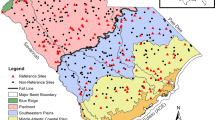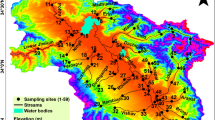Abstract
The ecoregion is currently widely used as the basic geospatial unit in freshwater biodiversity conservation. The popularly used delineation is usually based on the assumption that attributes of aquatic ecosystems are influenced by landscape-scale environmental variables. However, few ecoregion delineations attempt to establish the local validity of this assumption prior to delineation, and few studies check the correspondence of the derived ecoregion boundaries with the distributions of attributes of aquatic biota. In this study, we established an approach to overcome these shortcomings. The notable features of the approach are: (1) the delineation variables were filtered through a series of analytical steps to select those that best represented the aquatic community traits, and which avoided redundancy in the data; (2) the method was quantitative and repeatable; and (3) the derived ecoregion boundaries were checked for consistency with the spatial attributes of aquatic biota. The approach was applied in the Taizi River Basin, northeast China. The procedure proposed here filtered out altitude and annual precipitation as the best variables to include in the freshwater ecoregion delineation. Then, using the quantitative ISODATA classification method, the basin was classified into three ecoregions. A test of accuracy indicated that freshwater ecoregions matched well with the spatial distribution pattern of macroinvertebrate community attributes. Statistical analysis showed that natural geographical attributes and river attributes were different in the three ecoregions, and indices representing macroinvertebrate community attributes are significantly different as a whole among the three ecoregions. The case study proved this approach effective on ecoregion delineation.




Similar content being viewed by others
References
Abell R, Thieme ML, Revenga C, Bryer M, Kottelat M, Bogutskaya N, Coad B, Mandrak N, Balderas SC, Bussing W, Stiassny MLJ, Skelton P, Allen GR, Unmack P, Naseka A, Rebeccang NG, Sindorf N, Robertson J, Armijo E, Higgins JV, Heibel TJ, Wikramanayake E, Olson D, Lòpez HL, Reis RE, Lundberg JG, Sabaj Pérez MH, Petry P (2008) Freshwater ecoregions of the world: a new map of biogeographic units for freshwater biodiversity conservation. Bioscience 58:403–414
Allan JD, Castillo MM (2007) Stream ecology: structure and function of running water, 2nd version. Springer, Berlin Heidelberg New York
Allan JD, Johnson LB (1997) Catchment-scale analysis of aquatic ecosystems. Freshw Biol 37:107–111
Binckley CA, Wipfli MS, Medhurst RB, Polivka K, Hessburg P, Salter RB, Kill JY (2010) Ecoregion and land-use influence invertebrate and detritus transport from headwater streams. Freshw Biol 22:1205–1218
Dufrêne M, Legendre P (1997) Species assemblages and indicator species: the need for a flexible asymmetrical approach. Ecol Monogr 67:345–366
ERDAS Inc (1999) ERDAS Field Guide, 5th edn. Leica Geosystems, Atlanta
Esselman PC, Allan JD (2010) Relative influences of catchment- and reach-scale abiotic factors on freshwater fish communities in rivers of northeastern Mesoamerica. Ecol Freshw Fish 19:439–454
Frissel CA (1986) A hierarchical framework for stream habitat classification: viewing streams in a watershed context. Environ Manage 10(2):199–214
Gallant AL, Whittier TR, Larsen DP. Omernik JM, Hughes RM (1989) Regionalization as a tool for managing environmental resources. EPA/600/3-89/060. US Environmental Protection Agency, Corvallis
Groves CR, Jensen DB, Valutis LL, Redford KH, Shaffer ML, Scott JM, Baumgartner JV, Higgins JV, Beck MW, Anderson MG (2002) Planning for biodiversity conservation: putting conservation science into practice. Bioscience 52:499–512
Hargrove WW, Hoffman FM (2005) Potential of multivariate quantitative method for delineation and visualization of ecoregions. Environ Manage 34(suppl 1):39–60
Hawkins CP, Norris RH, Gerritsen J, Hughes RM, Jackson SK, Johnson RK, Stevenson RJ (2000) Evaluation of the use of landscape classifications for the prediction of freshwater biota: synthesis and recommendations. J N Am Benthol Soc 19(3):541–556
Higgins JV, Bryer MT, Khoury ML, Fitzhugh TW (2005) A freshwater classification approach for biodiversity conservation planning. Conserv Biol 19(2):432–445
Huston MA (1994) Biological diversity: the coexistence of species on changing landscapes. Cambridge University Press, New York
Iwan Jones J, Li W, Maberly SC (2003) Area, altitude and aquatic plant diversity. Ecography 26:411–420
Jacobson D, Schultz R, Encalada A (1997) Structure and diversity of stream invertebrate assemblages: the influence of temperature with altitude and latitude. Freshw Biol 38:247–261
Kawai T, Tanida K (2005) Freshwater insects of Japan: manual with keys and illustrations. Tokai University Press, Kanagawa
Kennard MJ, Pusey BJ, Olden JD, Mackay SJ, Stein JL, Marsh N (2010) Classification of natural flow regimes in Australia to support environmental flow management. Freshw Biol 55:171–193
Kong WJ, Sun OJ, Chen YN, Yu Y, Tian ZQ (2010) Patch-level based vegetation change and environmental drivers in Tarim River drainage area of West China. Landsc Ecol 25:1447–1455
Labbe TR, Fausch KD (2000) Dynamics of intermittent stream habitat regulate persistence of a threatened fish at multiple scales. Ecol Appl 10:1774–1791
Li W, Li QX, Jiang ZH (2007) Discussion on feasibility of gridding the historic temperature data in China with Kriging method. J Nanjing Inst Meteorol 30(2):246–252 (in Chinese with English abstract)
Maxwell JR, Edwards CJ, Jensen ME, Paustian SJ, Parrot H, Hill DM (1995) A hierarchical framework of aquatic ecological units in North America (Nearctic Zone). General technical report NC-176. US Department of Agriculture, Forest Services, North Central Forest Experiment Station, St. Paul
McCune B, Mefford MJ (1999) PC-ORD. Multivariate analysis of ecological data version 4.25. MjM software design, Gleneden Beach, Oregon
Minshall GW, Cummins KW, Peterson RC, Cushing CE, Bruns DA, Sedell JR, Vannote RL (1985) Developments in stream ecosystem theory. Can J Fish Aquat Sci 42:1045–1055
Munne A, Prat N (2004) Defining river types in a Mediterranean area: a methodology for the implementation of the EU framework directive. Environ Manage 34(5):711–729
Omernik JM (1987) Ecoregions of the conterminous United States. Ann Assoc Am Geogr 77(1):118–125
Paavola R, Muotka T, Virtanen R, Heino J, Jackson D, Maki-Petays A (2006) Spatial scale affects community concordance among fishes, benthic macroinvertebrates, and bryophytes in streams. Ecol Appl 16(1):368–379
Palmer MA, Hakenkamp CC, Nelson-Baker K (1997) Ecological heterogeneity in streams: why variance matters. J N Am Benthol Soc 16:189–202
Peterson WT, Keister JE (2003) Interannual variability in copepod community composition at a coastal station in the northern California Current: a multivariate approach. Deep-sea Res Part II 50:2499–2517
Poff NL (1997) Landscape filters and species traits: towards mechanistic understanding and prediction in stream ecology. J N Am Benthol Soc 16(2):391–409
Poff NL, Angermeier PL, Cooper SD, Lake PS, Fausch KD, Winemiller KO, Mertes LAK, Oswood MW, Reynolds J, Rahel FJ (2001) Fish diversity in streams and rivers. In: Chapin FS, Sala OE, Huber-Sannwald R (eds) Scenarios of future biodiversity. Springer, Berlin Heidelberg New York, pp 315–349
Quinn JM, Bryce Cooper A, Stroud MJ, Burrel GP (1997) Shade effects on stream periphyton and invertebrates: an experiment in streamside channels. New Zeal J Mar Fresh 31:665–683
Richards C, Haro RJ, Johnson LB, Host G (1997) Catchment and reach-scale properties as indicators of macroinvertebrate species traits. Freshw Biol 37:219–230
Santoul F, Soulard A, Figuerola J, Céréghino R, Mastrorillo S (2004) Environmental factors influencing local fish species richness and differences between hydroregions in south-western France. Internat Rev Hydrobiol 89:79–87
Soranno PA (2010) Using landscape limnology to classify freshwater ecosystems for multi-ecosystem management and conservation. Bioscience 60(6):440–454
Tonn WM (1990) Climate change and fish communities: a conceptual framework. T Am Fish Soc 119:337–352
Vannote RL, Wayne MG, Cummins KW, Sedell JR, Cushing CE (1980) The River Continuum Concept. Can J Fish Aquat Sci 37:130–137
Vinson MR, Hawkins CP (2003) Broad-scale geographical pattern in local stream insect richness. Ecography 26:751–757
Wright RG, Murray MP, Merril T (1998) Ecoregion as a level of ecological analysis. Biol Conserve 86:207–213
Zimmerman GM, Goetz H Jr, Mielke PW (1985) Use of an improved statistical method for group comparisons to study effects of prairie fire. Ecology 66:606–611
Acknowledgments
This research was supported by the “Major Science and Technology Program for Water Pollution Control and Treatment in China” (Grant No. 2008ZX07526-001, 2012ZX07501-001).
Author information
Authors and Affiliations
Corresponding author
About this article
Cite this article
Kong, W., Meng, W., Zhang, Y. et al. A freshwater ecoregion delineation approach based on freshwater macroinvertebrate community features and spatial environmental data in Taizi River Basin, northeastern China. Ecol Res 28, 581–592 (2013). https://doi.org/10.1007/s11284-013-1048-7
Received:
Accepted:
Published:
Issue Date:
DOI: https://doi.org/10.1007/s11284-013-1048-7




